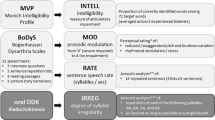Abstract
Dysarthria is an acquired neurogenic sensorimotor speech symptom and an integral part within the clinical spectrum of ataxia syndromes. Ataxia measurements and disability scores generally focus on the assessment of motor functions. Since comprehensive investigations of dysarthria in ataxias are sparse, we assessed dysarthria in ataxia patients using the Frenchay Dysarthria Assessment. The Frenchay Dysarthria Assessment is a ten-item validated test in which eight items focus on the observation of oral structures and speech functions. Fifteen Friedreich's ataxia patients and 15 healthy control individuals were analyzed using clinical and logopedic methodology. All patients underwent neurological assessment applying the Scale for the Assessment and Rating of Ataxia. In Friedreich's ataxia patients, the Frenchay sub-item voice showed to be most affected compared to healthy individuals followed by items such as reflexes, palate, tongue, and intelligibility. Scoring of lips, jaw, and respiration appeared to be mildly affected. Ataxia severity in Friedreich's ataxia patients revealed a significant correlation with the Frenchay dysarthria sum score. The introduction of a binary Adapted Dysarthria Score additionally allowed allocation to distinct dysarthria pattern in ataxias. The Frenchay Dysarthria Assessment proved to be a valid dysarthria measure in Friedreich's ataxia. Its availability in several languages provides a major advantage regarding the applicability in international clinical studies. Shortcomings of the Frenchay test are the multiplicity of items tested and its alphabetic coding. Numerical scoring and condensation of assessments in a modified version may, however, provide an excellent clinical tool for the measurement and scoring of dysarthria in ataxic speech disorders.




Similar content being viewed by others

References
Ziegler W, Vogel M, Gröne B (2002) Dysarthrie. Grundlagen–Diagnostik–Therapie. Thieme Verlag, 2. unveränderte Aufl, Stuttgart
Spencer KA, Slocomb DL (2007) The neural basis of ataxic dysarthria. Cerebellum 6:58–65
Böhme G (2003) Sprach-, Sprech-, Stimm- und Schluckstörungen. Band 1 Klinik. Urban & Fischer Verlag, 4. aktualisierte und erweiterte Aufl, München
Campuzano V, Montermini L, Molto MD et al (1996) Friedreich’s ataxia: autosomal recessive disease caused by an intronic GAA triplet repeat expansion. Science 271:1423–1427
Durr A, Cossee M, Agid Y, Campuzano V, Mignard C, Penet C, Mandel JL, Brice A, Koenig M (1996) Clinical and genetic abnormalities in patients with Friedreich’s ataxia. N Engl J Med 335:1169–1175
Harding AE (1981) Friedreich’s ataxia: a clinical and genetic study of 90 families with an analysis of early diagnostic criteria and intrafamilial clustering of clinical features. Brain 104:589–620
Schmitz-Hübsch T, du Montcel ST, Baliko L et al (2006) Scale for the assessment and rating of ataxia: development of a new clinical scale. Neurology 66:1717–1720
Weyer A, Abele M, Schmitz-Hübsch T, Schoch B, Frings M, Timmann D, Klockgether T (2007) Reliability and validity of the scale for the assessment and rating of ataxia: a study in 64 ataxia patients. Mov Disord 22:1633–1637
Cano SJ, Hobart JC, Hart PE, Korlipara LV, Schapira AH, Cooper JM (2005) International Cooperative Ataxia Rating Scale (ICARS): appropriate for studies of Friedreich’s ataxia? Mov Disord 20:1585–1591
Bürk K, Mälzig U, Wolf S et al (2009) Comparison of three clinical rating scales in Friedreich's ataxia (FRDA). Mov Disord 24:1779–1784
Klockgether T, Lüdtke R, Kramer B et al (1998) The natural history of degenerative ataxia: a retrospective study in 466 patients. Brain 121:589–600
Enderby PM (1991) Frenchay Dysarthrie-Untersuchung. Gustav Fischer Verlag, Stuttgart
Kent RD, Kent JF, Duffy JR, Thomas JE, Weismer G, Stuntebeck S (2000) Ataxic dysarthria. J Speech Lang Hearing Res 43:1275–1289
Tomik B, Krupinski J, Glodzik-Sobanska L, Bala-Slodowska M, Wszolek W, Kusiak M, Lechwacka A (1999) Acoustic analysis of dysarthria profile in ALS patients. J Neurol Sci 169:35–42
Schalling E, Hammarberg B, Hartelius L (2007) Perceptual and acoustic analysis of speech in individuals with spinocerebellar ataxia (SCA). Logoped Phoniatr Vocol 32:31–46
Singh A, Epstein E, Myers LM, Farmer JM, Lynch DR (2010) Clinical measures of dysarthria in Friedreich's ataxia. Mov Disord 25:108–111
Schöls L, Bauer P, Schmidt T, Schulte T, Riess O (2004) Autosomal dominant cerebellar ataxias: clinical features, genetics, and pathogenesis. Lancet Neurol 3:291–304
Durr A (2010) Autosomal dominant cerebellar ataxias: polyglutamine expansions and beyond. Lancet Neurol 9:885–894
Gentil M (1990) Dysarthria in Friedreich disease. Brain Lang 38:438–448
Conflict of interest
The authors declare that they have no conflict of interest.
Author information
Authors and Affiliations
Corresponding author
Additional information
A. Eigentler and J. Rhomberg contributed equally to this work.
Rights and permissions
About this article
Cite this article
Eigentler, A., Rhomberg, J., Nachbauer, W. et al. The scale for the assessment and rating of ataxia correlates with dysarthria assessment in Friedreich's ataxia. J Neurol 259, 420–426 (2012). https://doi.org/10.1007/s00415-011-6192-9
Received:
Revised:
Accepted:
Published:
Issue Date:
DOI: https://doi.org/10.1007/s00415-011-6192-9



